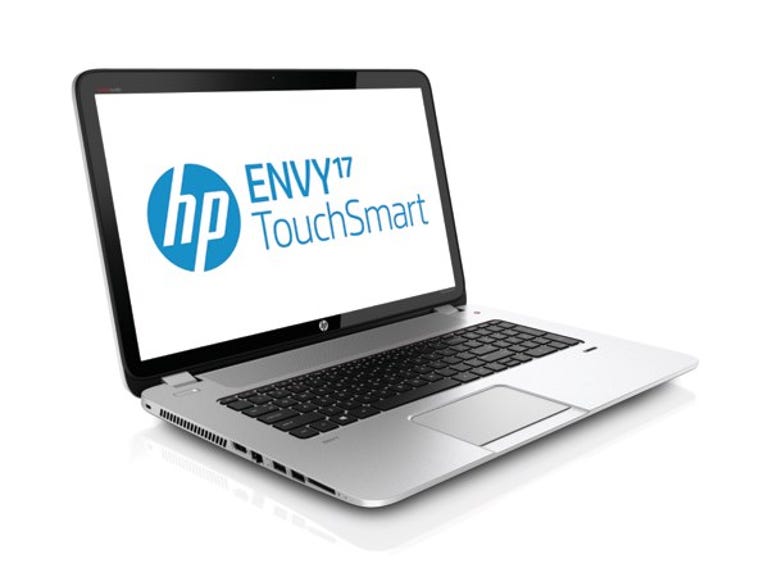 Why You Can Trust CNET
Why You Can Trust CNET HP Envy 17-j005TX review: HP Envy 17
HP's home for Haswell is more of a mansion than a weekend getaway, with plenty of room for entertaining.
Intel's new 4th Generation Core CPU is designed first and foremost to deliver lower power processing for the latest range of ultra-portable tablets and convertibles. So how does it perform when it's placed in something on the opposite end of the spectrum, like HP's huge Envy 17, a multimedia machine where the emphasis is on screen size and performance over portability and battery life?
The Good
The Bad
The Bottom Line
Design and features
On first appearances, the HP Envy 17 looks remarkably similar to Asus' competing 17-inch movie lover, the N750VJ. Borrowing the same polished aluminium exterior, it even unfortunately copies the same disappointing black plastic base. The keyboard in particular borrows heavily from the MacBook Pro's school of design, just like the N750VJ. Heck, it even uses a speaker system that all the cool kids will recognise, with speakers by Dre, rather than the Bang & Olufsen boomboxes used in the Asus.
Unfortunately, the quality of the keyboard isn't quite up there with its competitor, with the plastic mounting plate flexing slightly in use. The island design is easy enough to use, thanks to the almost full-sized keys, but we can't say the same about the horrible touch pad. Pointing is accurate enough, but the buttons are simply dismal, with a vague, inaccurate response that makes it hard to determine when you've actually clicked anything. Considering so many touch pads these days get the buttons so right, it's a surprise to see that HP still can't master such a simple feature.
The matte finish on the 17.3-inch display is a welcome inclusion, while the 1920x1080 resolution is mandatory on such a billboard of a screen. Image quality is rock solid across the board, passing all of our lagom.nl tests with ease, though the LED backlighting means it's a long way off the new breed of IPS displays starting to arrive in laptops. Weighing in at 3.2kg, it's obvious that the Envy 17 is not designed for the upwardly mobile user; this beast will be happiest when strapped to a desk.
Connections, performance and battery
The large screen ensures the Envy 17 is built around a relatively chunky chassis, providing ample space for connections. Beginning with the right-hand side, we see twin USB 3.0 ports alongside a 3.5mm stereo minijack, as well as a Blu-ray burner. The opposite side is filled with two more USB 3.0 ports, not to mention HDMI out, Ethernet and an SD card reader. The rear is devoid of any connections, instead being used as a large output for the cooling system, blowing air away from the user.
At the heart of the hardware within is Intel's new 4th Generation Core i7-4700MQ behemoth, a quad-cored, Hyper-Threaded beastie that fires along at a very speedy 3.4GHz under load. This is backed up by Nvidia's budget GPU, the GT 740M, a rung below the GPU found in the Asus N750VJ. Our sample arrived with a whopping 16GB of DDR3 running at a speedy 1600MHz, easily the equal of most desktops, while long-term storage was delivered via dual 1TB mechanical drives. An SSD would do wonders to speed up overall performance; even a small SSD for caching would have helped. Wi-Fi is once again limited to 802.11n, with yet another laptop manufacturer ignoring the new 802.11ac standard.
It's likely due to these mechanical hard drives that the system didn't feel as snappy to use as the hardware would suggest. However, it performed exceptionally well in our overall system test, PCMark 8, coming close to being one of the fastest Haswell machines we've tested; perhaps the huge amount of system memory allowed the benchmarks to be cached, avoiding any disk access?
Game performance wasn't quite as impressive, with the GT 740M struggling to keep up with today's demanding graphics. It'll handle older games with ease, but don't expect to be able to fire up any of the impending next-gen titles due at the end of the year.
We didn't expect such a speed demon to perform too well in our PowerMark benchmark, and the Envy 17 headed straight to the bottom of the pack, posting the worst result at a touch over two hours. For the majority of users interested in this kind of machine, this won't be an issue, as they'll always be within metres of a power outlet.
Choose a benchmark: PCMark 8 | Tomb Raider | Hitman Absolution
Conclusion
With the 17-inch category proving to be surprisingly popular, the Envy 17 has a couple of flaws that prevent it from being one of the best. The reliance upon mechanical drives in our sample definitely slowed down system responsiveness in day-to-day use, while the budget GPU barely coped with games. Considering there are similarly priced machines with neither of these flaws, and a vastly superior touch pad to boot, the Envy 17 doesn't quite match the quality of the CPU powering it.


